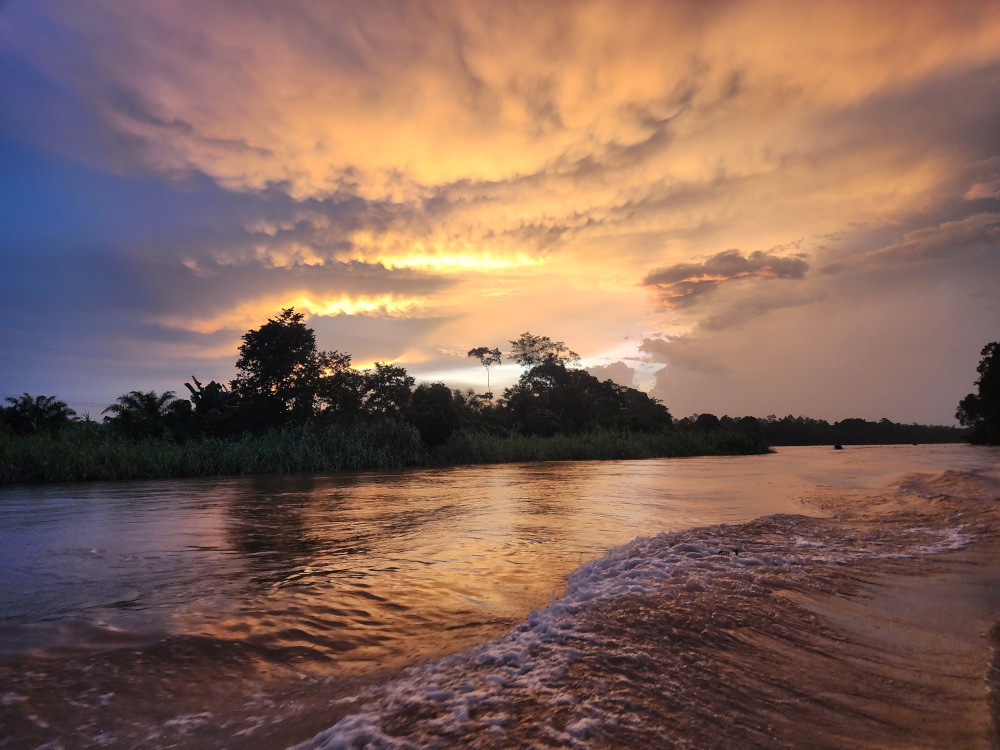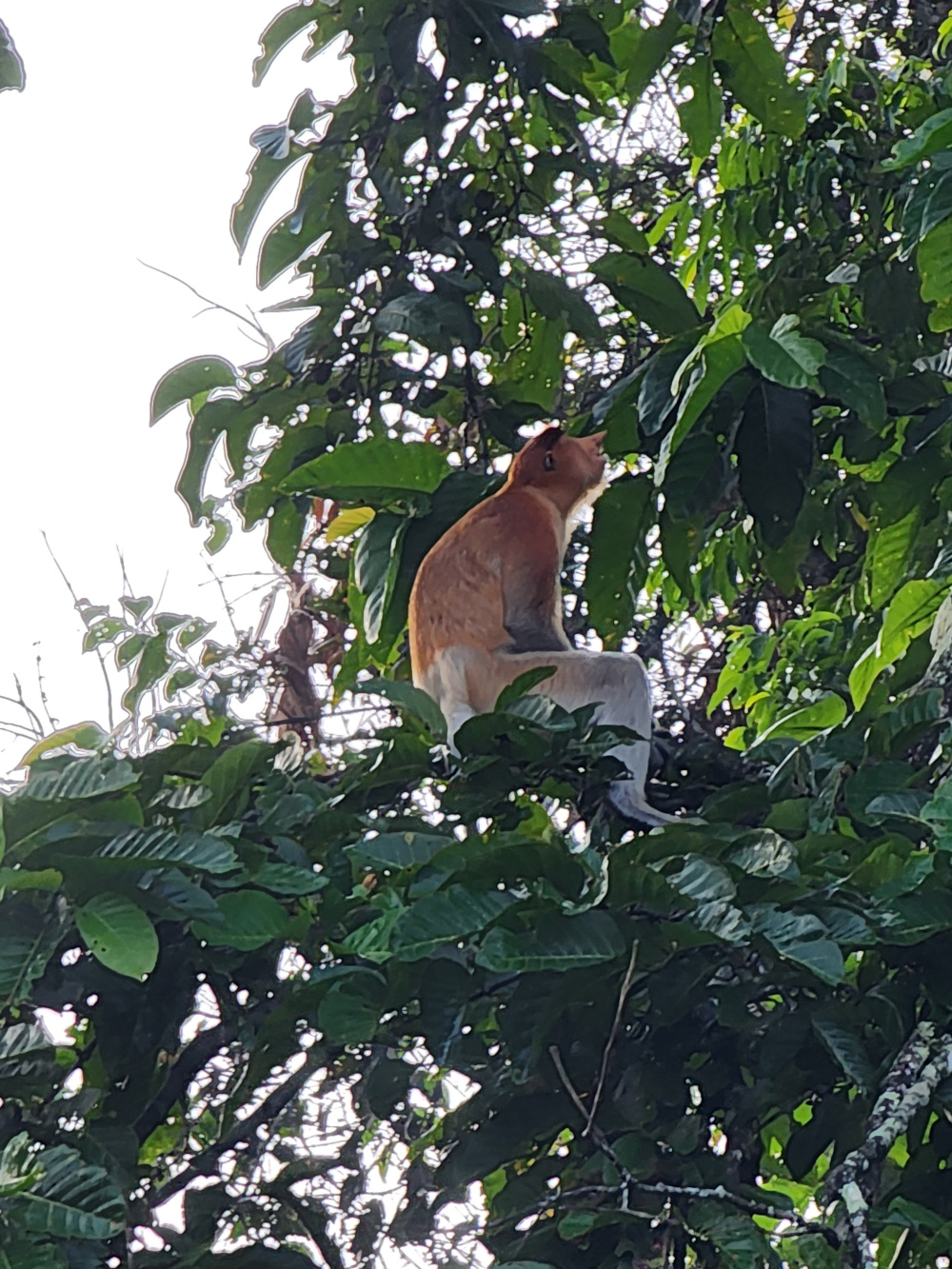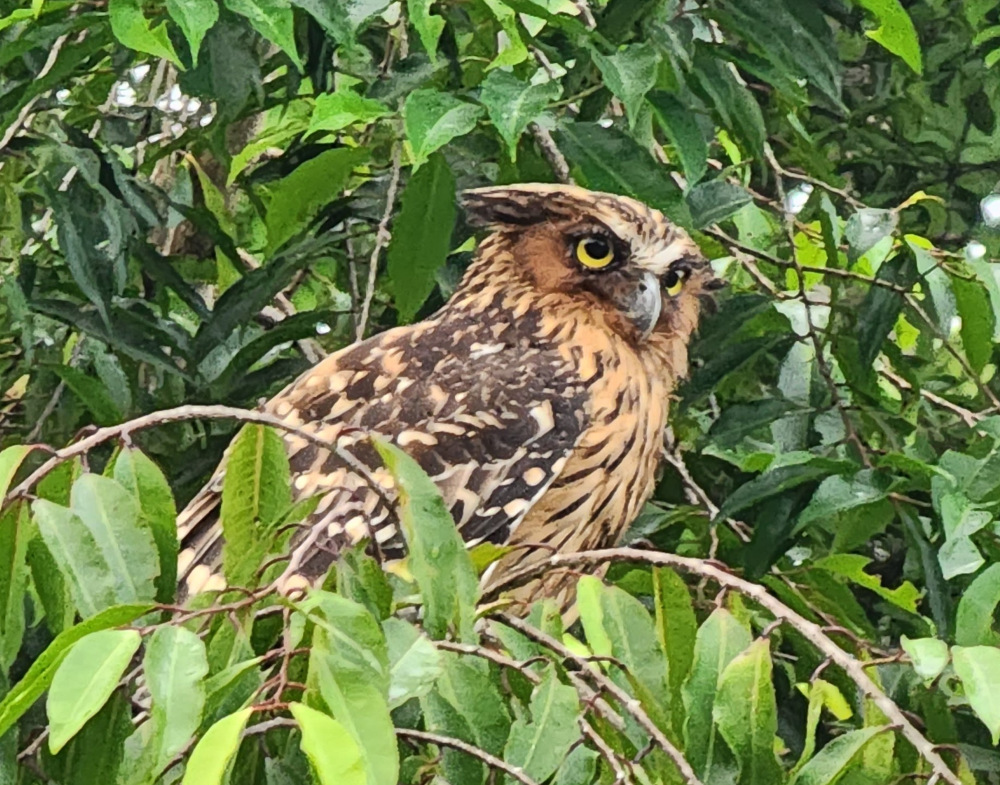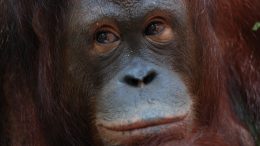The bus from Semporna, Malaysia, to the Kinabatangan Wildlife Preserve wound through an unending expanse of palm agricultural fields. On Borneo oil palm plantations line every road, and it seemed almost no natural forest remained.
That agricultural development comes with a cost to this biodiversity hotspot: Of the more than 200 species of mammals and 600 species of birds in the state of Sabah, more than half are classified as threatened or endangered.
After three hours of driving through desolate oil palm farms, we approached the preserve and finally began to see wildlife. Gibbons, with their long muscular arms, hung from trees on the side of the road. Bornean gibbons are endangered due to habitat loss from deforestation for logging and oil palm agriculture, a recurring theme. The illegal pet trade also poses a significant threat: In addition to taking young gibbons from the wild, men kill adult mothers who try to protect their offspring from being stolen.
I was excited to see gibbons, but I was there for the orangutans.
We arrived at the Sukau Backpackers Hotel, located near the bank of the Kinabatangan River. We chose to stay near the river, since all animals need to drink and we’d have a better chance of spotting orangutans.
At the lodge curious long-tailed macaques hung out by the outdoor dining room, waiting for food. Water monitor lizards lurked in the stream beneath the wooden dining room and bridge pathways, eyeing a litter of newborn puppies. Frogs called from the stream banks and trees at night, but despite my efforts, I couldn’t find them. Frogs on this side of the island were more clandestine than the green paddy frogs I’d studied in Kota Kinabalu.
The modest private room came complete with very large black carpenter ants, scouting for scraps, keeping us company in their own way.
Our accommodations were insignificant, but we weren’t there to relax. We were there to tour the river and the jungle with our local guide, “Jon” (not his real name), a man who’d grown up in the area and was a knowledgeable member of a tour guide union. Jon is a conservationist too, taking the time to teach me about the perils facing wildlife in this area, the Kinabatangan Wildlife Sanctuary, specially preserved to ensure palm oil plantations do not encroach.
I’d been dreaming of this journey for a long time and was thrilled to enjoy it as a traveler, not a researcher.
When I was a child in the 1990s, I used to buy 25-cent chocolates called EnvirOmints. They were one-inch chocolate-mint squares, and each came with a little card featuring an endangered species. The front displayed a picture of the animal, while the back provided details about their habitat, and half of the profits from chocolate sales went to protect them. I bought as many as I could, collecting and trading the cards with my best friend (now also a biologist) until we had all 48 species.
My favorite card was the orangutan with bright orange hair, big moon face, and little round eyes. For some reason, at just nine years old, it pained me to think that this great ape, living somewhere across the world in remote jungles and minding its own business, could someday be extinct.
Three decades later I wondered: Had I gotten there in time?
Jon took us out on a sunset boat tour along the river, and my hypothesis proved correct: the animals came to the water to drink. A mother pygmy elephant emerged from the tall grass with her baby. The driver cut the motor, and we stopped and stared in awe. They were everything I’d dreamed: serene, peaceful, and majestic.

Jon explained that as of September 2023, the species is considered endangered by the International Union for Conservation of Nature, with only about 115-120 pygmy elephants remaining in this area. He’d noticed a significant reduction in their numbers since he began guiding; he used to always see elephants lining the riverbank to eat and drink. We were lucky to spot two individuals, especially since that time of year was when they tend to migrate.
In late September, he explained, fewer animals were around, but in April there were more elephants and monkeys along the river. As the forests shrink around them, Bornean pygmy elephants are forced to venture beyond their usual paths. These gentle giants wander into the sprawling oil plantations in search of food, where palm farmers have been known to kill or poison them.
Jon mentioned that in 2005, proboscis monkeys were abundant all along the river, too. Today only two family groups remain along this stretch. The population has declined by over 50%.

Ironically, proboscis monkeys are still somewhat more common than other monkeys in the area because their big noses are seen as unattractive by humans, who don’t really care to keep them as pets. This quirky feature, which some might consider ugly, actually helps the monkeys avoid the greedy hands of people. Despite this advantage their numbers are still plummeting due to the persisting destruction of natural habitat for oil palm agriculture. I enjoyed watching their big families hanging out in the trees above the river, and I wished they were even more densely populated, as Jon described from his past.
Over the coming days, we would travel up and down the river in the early mornings, near dusk, and late at night. We spotted bizarre-looking and uniquely colored birds: black-and-red broadbills, stork-billed kingfishers, oriental pied hornbills, and Wallace’s hawk-eagles, all lining the riverbanks, waiting to meet and dine as if it were a town center. In the dark of the night, a buffy fish-owl hunted a painted bronzeback snake coiled in the grass, stalking frogs while they sang to their mates and feasted on mosquitoes and flies.
All these private lives were laid out for us to see, illuminated by a headlamp on that quiet riverboat.

During the midday heat, when the animals were deep in the jungle sleeping or foraging, we set out to look for orangutans.
Wearing rubber waders, long pants, a long-sleeved shirt, and a hat in the persistent heat felt stifling, but they were necessary to shield us from the swarms of mosquitoes. I had never encountered such a densely populated mosquito cloud; each step we took stirred them into a thick fog that made it look like it was snowing mosquitoes.
My attention was diverted from the mosquitoes when I was attacked by terrestrial leeches. They clung to the tips of tree branches using their vibrational senses to detect our approach. As I walked by, they suctioned onto my hands and clothes. I warned myself not to touch anything. Admittedly they were beautiful, with their green and gold coloration.
We trekked through the jungle, our eyes peeled for large droppings or fruit peels, but no orangutans could be seen or heard — only a tiny forest frog hidden under a mushroom cap.

Back on the river, we heard a cacophony of shrill bird calls coming from inside a large birdhouse. In this area swiftlets build their nests using saliva. Jon explained that some locals exploit these birds by constructing artificial birdhouses equipped with radios that play bird calls. These houses attract the swiftlets, encouraging them to nest inside. The nests are then harvested and sold to the Chinese market for traditional medicine. This practice has decimated the swiftlet population.
Recently Jon and other guides rallied together and submitted a complaint to the local government about this issue. But the people who’d built the artificial nesting houses managed to obtain a fraudulent license, allowing them to operate.
“This is a clear case of corruption; they must have paid someone within the government for the license,” said Jon.
In China birds’-nest products are a multibillion-dollar industry, deeply rooted in perceived health benefits among the affluent. These nests, harvested from swiftlets of the Apodidae family, are prized for their high protein content and alleged medicinal properties. They’re used in soups and traditional Chinese medicine, where they are (wrongly) believed to improve skin complexion and boost the immune system.

It was disheartening to learn about the human-caused decline of these animals, but I felt relieved that people like Jon live there, informed and compassionate guides dedicated to protecting the wildlife they love and rely on.
We set out again on the fourth morning in search of orangutans. These remarkable “people of the forest” (as their name means) have moved from the endangered category to critically endangered on the IUCN Red List. They require mature forests to nest and find their traditional foods, but palm oil plantations have consumed up to 30% of the island’s forest land, and planting continues.
My personal mission at the Kinabatangan River was to check on orangutans in their wild and free home. Jon fueled up the boat early, and we drifted slowly down the river with the current, weaving through dense overgrowth, not stopping to photograph birds or monkeys. After hours of boating, we arrived at a large clearing where the river widened. It was hot in this shadeless stretch, and I felt uneasy about finding our way back after making so many turns down various branches of the river.
But just then Jon shouted from the front of the boat: “There!”
And there he was. The adult orangutan was as huge, calm, and majestic as I had imagined. He sat perched in the canopy of a tall tree, eating his breakfast while minding his own business. His broad, moon-shaped face looked wise, as if he had a lot to say. I simply watched him and, feeling like an intruder in his home, refrained from taking an unsolicited photo.
I needed to witness him with my own eyes, to find hope to continue the fight to protect these incredible beings in any way I can.
It took four continuous days to find a single orangutan, yet each moment spent searching reinforced that every ounce of effort we invest today is vital to ensuring that these remarkable lives do not vanish from our planet forever.
Oil palm agriculture is rampant on Borneo. The demand for palm oil has skyrocketed globally due to its versatility and low production costs. Palm oil is an ingredient in nearly all shelf-stable processed and packaged foods, snacks, chips, cookies, and candies. Governments in Borneo, seeking economic growth, have facilitated the expansion of oil palm cultivation, prioritizing short-term financial gains over long-term environmental sustainability.
The good news is that consumers can reduce demand by choosing not to purchase junk food. Opting for sustainable choices over junk food isn’t just good for our health — it’s essential for the survival of Borneo’s iconic animals and their dwindling habitat. Every small purchase decision we make contributes to the future of these animals.
I stared at the single wild orangutan Jon had found after four days of boating and trekking through the hot, parasite-ridden jungle. After nearly 35 years of wondering if these creatures were going to be okay, I found myself unsure. The one I’d seen was okay at that moment, but his entire existence hangs on a thread. A thread directly tied to our actions and the choices we make every day in faraway parts of the world.
Governments can and should be expected to conserve natural resources, but governments can also be corrupt and prioritize short-term financial gains. This is why, as global consumers, we need to take responsibility for our role in environmental conservation.
While looking directly at the old orangutan’s innocent, stoic face, I vowed never to buy anything containing palm oil again — for him, for Jon, for me, and for all of us.

Previously in The Revelator:
Save This Species: Sumatran Orangutans


